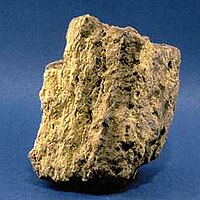
Photo from wikipedia
Abstract Large quantities of pyrite have been discovered near the ore-bearing segments of the sandstone-type uranium deposits in the North Ordos Basin. In this study, the electron probe microanalysis, scanning… Click to show full abstract
Abstract Large quantities of pyrite have been discovered near the ore-bearing segments of the sandstone-type uranium deposits in the North Ordos Basin. In this study, the electron probe microanalysis, scanning electron microscopy, and isotope geochemical analysis were used to systematically investigate the morphology, composition, and S isotopes of the pyrites in these deposits, and their genetic order relative to the other main altered minerals. Based on the regional tectonic evolutionary sequence of the basin, the relationships between the pyrites and uranium mineralization are discussed. Macroscopically, the pyrites were found to occur in lumpy, banded, disseminated, star-like or sheet-like form. Microscopically, they exist either as detrital grains or inside detrital grains, as idiomorphic grains, in colloidal or framboidal form, inside mica minerals, in banded or petaloid form, and in other forms related to biological cells or microorganisms. The δ34S‰ values in the pyrites are highly variable (−7.3‰ to −37.2‰), but principally in the proximity of −30‰, and display obvious biogenic origin. Taking into consideration the extremely low U contents in the pyrites and achavalites (iron selenide), the genetic order of the main altered minerals is determined as follows: detrital pyrites > clay mineral overgrowths > micritic calcites during the diagenetic stage; and achavalites > pyrites > coffinite/pitchblende > vanadium oxides > sparry calcites during the metallogenic stage. The broad presence of pyrites in the Jurassic Yan'an Formation during the basin’s evolution provided detrital pyrites and organic detritus for the overlying formations. The Zhiluo Formation, host of the uranium mineralization, is also home to some primary spherical colloidal or framboidal pyrites. The Cretaceous was the main epigenetic uranium metallogenetic period as well as the main pyrite development period of the area. The pyrites, which are typically colloidal, have cemented the earlier framboidal pyrites and other minerals and are closely associated with the redox reaction related to uranium mineralization. In the Paleogene, uranium mineralization mainly occurred by the redox migration of early shallow deposits to, and fresh pyrites forming in deeper levels.
Journal Title: Ore Geology Reviews
Year Published: 2019
Link to full text (if available)
Share on Social Media: Sign Up to like & get
recommendations!